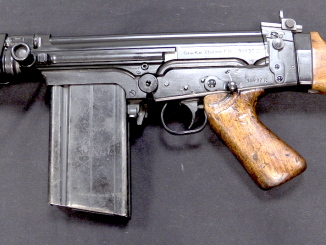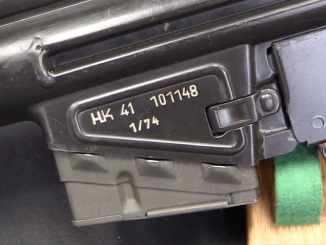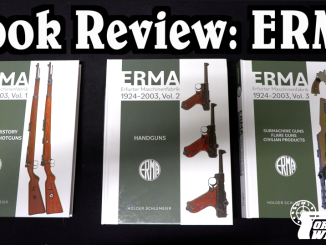“The Schmeisser Myth: German Submachine Guns Through Two World Wars” is a newly published history of SMG development from the Villar Perosa and MP18 through the MP38 and MP40, written by Martin Helebrant. Given that it is published by Collector Grade, it should be no surprise that it is an excellent volume, which includes both historical and developmental context as well as detailed collectors’ information on markings, variations, and production numbers.
Edit: Mr. Helebrant has requested that I amend this to note the contributions of several co-authors who made the book possible: Mr. Alex Cruiming, Arnt Nedrebo, and Reidar Daae – and editor R. Blake Stevens.
“The Schmeisser Myth” is available through Collector Grade directly, or at Amazon.




“MP38 and MP40”
Which were NOT designed by neither of Schmeisser family, despite being sometimes dubbed Schmeisser, history-compliant digit-less name is Erma.
Designed by Vollmer, unless I’m mistaken. Thing is, it used several of ol’ Hugo Schmeisser’s *patents* and, for that matter, many of the magazines were marked “Schmeisser.” In any case, soldier’s can hardly be faulted for various nick-names… North Americans called the “pa-pa-sha” the “burp gun,” many Tommies referenced all, erm, “machine carbines” as “Tommy guns” from ol’ J. Talifierro Thompson hisself, and so on. Note too the adoption of various German portmanteaux–e.g. “Panzerkampfwagen” as merely “panzer” and thus “panzers” for short… “Flakabwehrkanone” becomes “flak gun” but then before too long becomes a bizarre verb: “catching flak” “got flak” “received flak” “a storm of flak” und so weiter.
ERMA itself from “Erfurt Maschinenfabrik” nicht war?
The “MP.40 *ahem* Schmeisser” vs. “Vollmer” or whatever the more correct attribution may have been. I do like the Swedes’ practice of shortening the SMG to “k-pist.”
“portmanteaux”
Soviet Union generally used abbreviations for weapons name, however one of oddity of older system (1920s-1930s) is that it compromise only adjectives and designers name, without weapons category name, for example
MT stands for Maxim-Tokarev [machine gun]
TK stands for adjective(Tula)-Korovin [automatic pistol]
TT stands for adjective(Tula)-Tokarev [automatic pistol]
DT stands for Degtyaryov-adjective(tank) [machine gun]
and so on, later category were added for example
PPSh stands for sub-machinegun-Shpagin
PTRS stands for anti-tank-rifle-Simonov
hence writing “anti-tank rifle PTRS” is redundant
“shortening the SMG to “k-pist.””
Russian term for sub-machine gun is пистолет-пулемёт used from 1930s and also from 1930s abbreviated to ПП, see for example ПП-2000: http://modernfirearms.net/smg/rus/pp-2000-e.html
“(…)German portmanteaux(…)”
And, at least in case of MP, can’t decide how to write it – using points or not, using spaces or not. Examples:
M.P.18,I. or M.P.41 (point after each letter)
MP.28,II (point after group of letter)
MP 40 (space after group of letter)
The general rule is that use of points (and spaces) became less frequent over time. So s. M. G. changed to s.M.G. and finally sMG. But as you observe, there was no predictable way. For example in a Luftwaffe manual that uses M.G. 17 one can find at the same time SmK (not S.m.K.).
Bundeswehr finally decided not to use any points in abbreviations.
Acronyms shearing points (or rather periods) is pretty common also in English. If you look at old English language documents you will “U.S.A.” much more commonly than “USA”, especially in American English, but in general the use of periods in acronyms is becoming less frequent.
““Flakabwehrkanone” becomes “flak gun” ”
It should be Fliegerabwehrkanone or Flugabwehrkanone, your word is something like “cannon defending against anti-aircraft defense”.
And not flak but FlaK xor Flak. “flak gun” is also stylistic error as it means “anti-aircraft cannon gun”
““Panzerkampfwagen” as merely “panzer” and thus “panzers” for short”
But despite using short forms, it looks that Germans like to have complicated named for equipment for example vehicle known in today-literature as Sd.Kfz.251 is in full name Mittlerer Schützenpanzerwagen Sonderkraftfahrzeug 251 (m.SPW SdKfz.251) and vehicle known as Sd.Kfz.247 Ausf. A is Schwerer geländegängiger gepanzerter Personenkraftwagen (6 Rad) mit Fahrgestell des l gl.Lkw (and this is NOT total full form!) see: http://www.tanks-encyclopedia.com/ww2/nazi_germany/SdKfz-247.php for images of Sd.Kfz.247
I think you should look at this: Why the MP38 and MP40 were called the “Schmeisser” [http://www.mp40.nl/index.php?page=models].
While the link you mention correctly says there was no MP 38/40 (because this was used as an informal way to refer to MP 38 and MP 40) the explanation of “Schmeisser” due to Erma wanting to do post-war business with the US is, well, a little far-fetched, to say the least.
American authors like Ray F. Dunlap insisted on using incorrect names like Schmeisser or Spandau (for the MG 42). And this tradition is continued today by calling the AK/AKM family of assault rifle AK-47, knowing perfectly well that this designation was never used in any Soviet/Russian field manual for these weapons. Not to mention using “7.92 mm” (invented in 1918) for the German 7.9 mm caliber (invetend in 1888).
Roy Dunlap’s use of ‘Schmeisser’ to describe the MP38 and MP40 was a general usage in the U.S., of course, but his calling the MG42 a ‘Spandau’ is likely a reflection of his service in North Africa alongside British and Commonwealth ordnance personnel who used that term.
The British were the ones who mistakenly typed the Erma MPs as “Schmeissers”, because Hugo had been involved in designing some earlier SMGs for the Reichswehr.
Of course, there’s still an extant photo in this book;
https://www.amazon.com/Great-Weapons-World-War-II/dp/0802711383
Of a wartime British “German small arms” display in London, which has a Haenel MP43 hanging next to an Erma MP40. It not only calls the MP40 a “Schmeisser”, it describes the MP43 as “Simplified version of Schmeisser for faster production”.
No, really.
I think they hit the trifecta of wrong guesses, right there.
cheers
eon
“mistakenly typed the Erma MPs as “Schmeissers””
One explanation might be that M.P. 41 has text М. Р.41, Patent Schmeisser C.G.Haenel, Suhl, see here: http://modernfirearms.net/smg/de/mp41-schmeisser-e.html and as it was similar mechanic-wise to MP 40 name Schmeisser was applied to MP 40.
BTW: Now, I found that there exist Schmeisser 1911 automatic pistol, which is modern (in sense of production), see photo here:
http://www.armoury-online.ru/articles/pistols/germany/schmeisser-1911/
as you can see it is derived from Colt Government automatic pistol and has big SCHMEISSER text. I am not sure how would Louis or Hans or Hugo Schmeisser react if they would be still alive…
And there is also SCHMEISSER SLP-9, see photo here:
http://www.armoury-online.ru/articles/pistols/germany/SLP-9/
And there is also Mauser but not Mauser, i.e. M2 automatic pistol:
http://www.armoury-online.ru/articles/pistols/germany/M2/
http://modernfirearms.net/handguns/hg/de/mauser-m2-e.html
it was NOT developed by or for Mauser Werke, but it use MAUSER name and Mauser logo on left side (see 1st link), it has READ MANUAL BEFORE USE text on right side (see 2nd list) which so far I know is not encountered on original Mauser pistols like 1910, 1914 or HSc.
Based on their products page the current “Schmeisser” company only markets other people’s designs. http://schmeisser-germany.com/products
Lots of AR-15 variations and accessories and the SLP-9 pistol is a relabeled Montenegrin Tara TM-9 ala Springfield XD. At a guess the 1911 is also a private label job from Armscor or another established 1911 makers since the accessory rail on the frame is a common variation.
As a matter of interest the original British term for what German forces termed ‘Machine Pistol’ was ‘Machine Carbine’. Sub machine gun was always considered gangster terminology and frowned upon. Machine carbine/machine pistol always seemed to me to be more useful terms but ‘SMG’ now seems to universally accepted by English speakers.
To the average Brit over a certain age all German SMGs(!)are Schmeissers and all MGs are Spandaus. I recall explaining things to an ex-service man who had been on the receiving end of them in Italy during WWll and all I got was a long pitying look!
Pity I can’t afford collector grade books anymore. I lost all mine in a house fire.
Impressive review, Ian. We currently offer this book on our website, abramsantiques.com, along with hundreds of other militaria and firearms reference books.